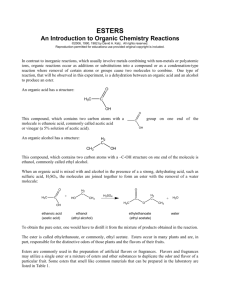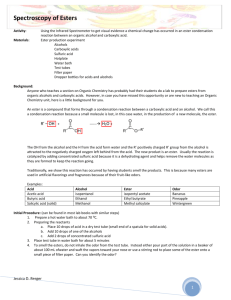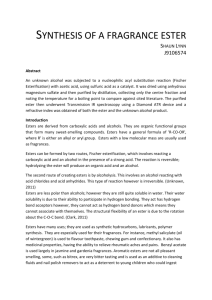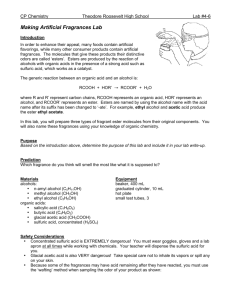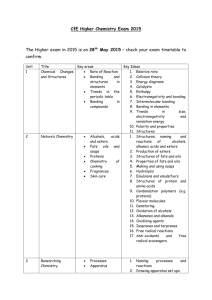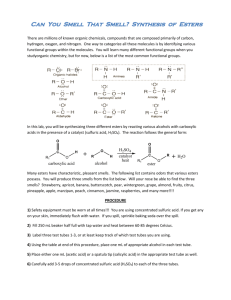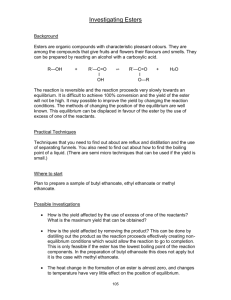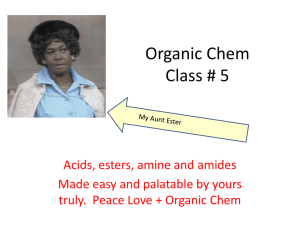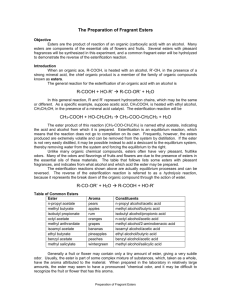Microscale preparation of some esters lab
advertisement
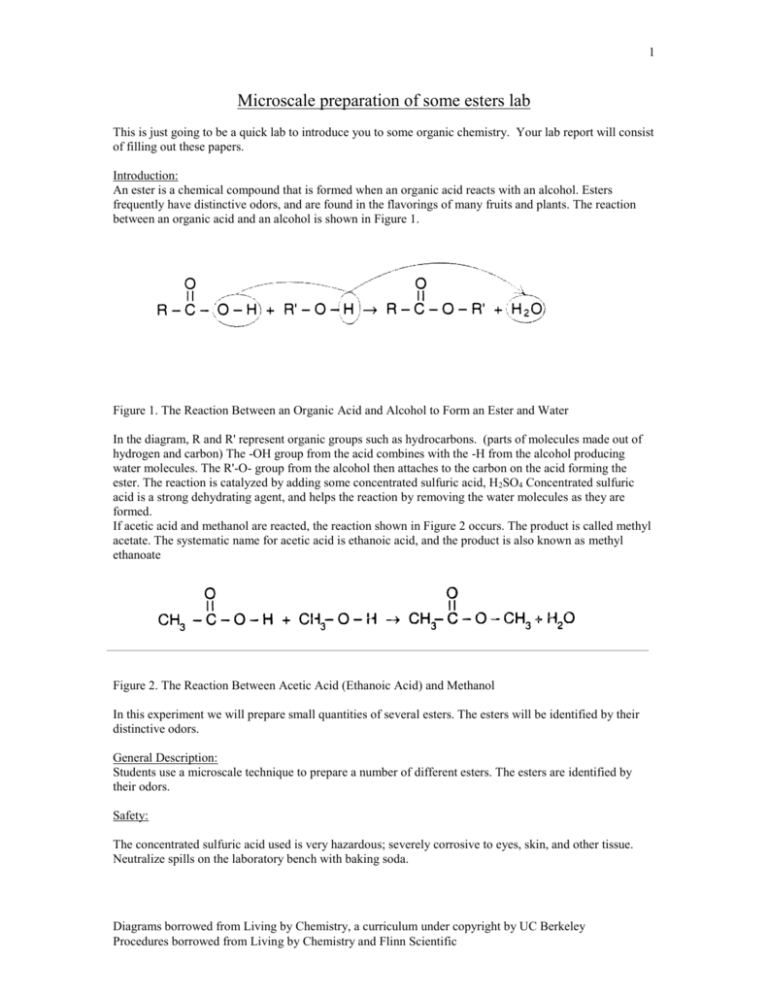
1 Microscale preparation of some esters lab This is just going to be a quick lab to introduce you to some organic chemistry. Your lab report will consist of filling out these papers. Introduction: An ester is a chemical compound that is formed when an organic acid reacts with an alcohol. Esters frequently have distinctive odors, and are found in the flavorings of many fruits and plants. The reaction between an organic acid and an alcohol is shown in Figure 1. Figure 1. The Reaction Between an Organic Acid and Alcohol to Form an Ester and Water In the diagram, R and R' represent organic groups such as hydrocarbons. (parts of molecules made out of hydrogen and carbon) The -OH group from the acid combines with the -H from the alcohol producing water molecules. The R'-O- group from the alcohol then attaches to the carbon on the acid forming the ester. The reaction is catalyzed by adding some concentrated sulfuric acid, H 2SO4 Concentrated sulfuric acid is a strong dehydrating agent, and helps the reaction by removing the water molecules as they are formed. If acetic acid and methanol are reacted, the reaction shown in Figure 2 occurs. The product is called methyl acetate. The systematic name for acetic acid is ethanoic acid, and the product is also known as methyl ethanoate Figure 2. The Reaction Between Acetic Acid (Ethanoic Acid) and Methanol In this experiment we will prepare small quantities of several esters. The esters will be identified by their distinctive odors. General Description: Students use a microscale technique to prepare a number of different esters. The esters are identified by their odors. Safety: The concentrated sulfuric acid used is very hazardous; severely corrosive to eyes, skin, and other tissue. Neutralize spills on the laboratory bench with baking soda. Diagrams borrowed from Living by Chemistry, a curriculum under copyright by UC Berkeley Procedures borrowed from Living by Chemistry and Flinn Scientific 2 The organic acids and alcohols are flammable. Use great care around flames. Do not heat directly with a burner, but use a water bath. The alcohols are all poisons. Do not ingest them. Methyl alcohol is absorbed through the skin. Wash yourself with soap and water if you spill some on yourself. A number of the organic acids and alcohols have strong and offensive odors. They may also be skin irritants. Use them in the hood. Wash spills off with large amounts of water. Never smell a compound by putting it directly under your nose. Instead, hold the compound at least eight inches from your face with one hand, and use your other hand to gently waft the vapors toward your nose. Wear goggles at all times. Materials: Possible organic acids: formic acid (methanoic acid): CHOOH Propionic acid (propanoic acid) CH3CHCOOH salicylic acid o-C6H4(OH)COOH acetic acid, 17.4 M (glacial) (concentrated) CH3COOH possible alcohols: methyl alcohol (methanol) CH3OH ethyl alcohol (ethanol) CH3CH2OH propyl alcohol (n-propanol, isopropyl alcohol) CH3CHOHCH3 butyl alcohol (butanol) CH3CH2CH2CH2OH other substances: sulfuric acid, 18 M (concentrated): H2SO4 Procedure: 1. Prepare a hot water bath: a. Fill a 400 mL beaker about half full with water. b. Heat the water to boiling, and then turn off the flame or the hot plate. While you are preparing the hot water bath, you can set up preparing the ester. c. When you are ready for your water bath, take it to your work station or table and place atop of one of the metal bases so you do not burn the countertop or table. You do not have to conduct the lab atop of the hot water bath. 2. Prepare the ester: a. Place 10 drops of one of the organic acids in a dry test tube. (Write down which organic acid you are using.) If using salicylic acid, use a small spatula full, about 0.08 g. b. Add 10 drops of one of the alcohols. Write down which alcohol you use. c. Add 2 drops of concentrated sulfuric acid. d. Put the test tube in the beaker of hot water and let stand for five minutes. e. The odor of the ester is more easily detected when the ester is mixed in some water. NEVER try to directly smell the ester while it is still hot. Put about 100 mL of water in a 250 mL beaker. Pour the Diagrams borrowed from Living by Chemistry, a curriculum under copyright by UC Berkeley Procedures borrowed from Living by Chemistry and Flinn Scientific 3 contents of the test tube into the beaker and swirl it to mix the contents. Carefully smell the ester after it is mixed with water by wafting some of the vapors toward your nose. Can you identify the odor? f. Do a minimum of two reactions, more if time allows. g. Record the name and formula of each acid and alcohol used, and identify the odor of the ester (if you can,) or describe its odor. Data: Acid used alcohol used smells like? Clean-up: The solutions used to prepare the esters can be safely washed down the sink with a large amount of water. The ethyl acetate (formed from ethanol and glacial acetic acid) can be saved and used as a solvent, or can be evaporated. Follow-up questions: 1. Draw the structural formulas for the following acids and alcohols. Examples are given in the introduction. formic acid (methanoic acid): CHOOH Propionic acid (propanoic acid) CH3CHCOOH acetic acid, 17.4 M (glacial) (concentrated) CH3COOH methyl alcohol (methanol) CH3OH ethyl alcohol (ethanol) CH3CH2OH propyl alcohol (n-propanol, isopropyl alcohol) CH3CHOHCH3 Diagrams borrowed from Living by Chemistry, a curriculum under copyright by UC Berkeley Procedures borrowed from Living by Chemistry and Flinn Scientific 4 butyl alcohol (butanol) CH3CH2CH2CH2OH 2.Using the introduction and your text book for help, explain what an ester is. 3. Draw the general structural formula for a carboxylic acid. 4. Draw the general structural formula for an alcohol. Diagrams borrowed from Living by Chemistry, a curriculum under copyright by UC Berkeley Procedures borrowed from Living by Chemistry and Flinn Scientific
